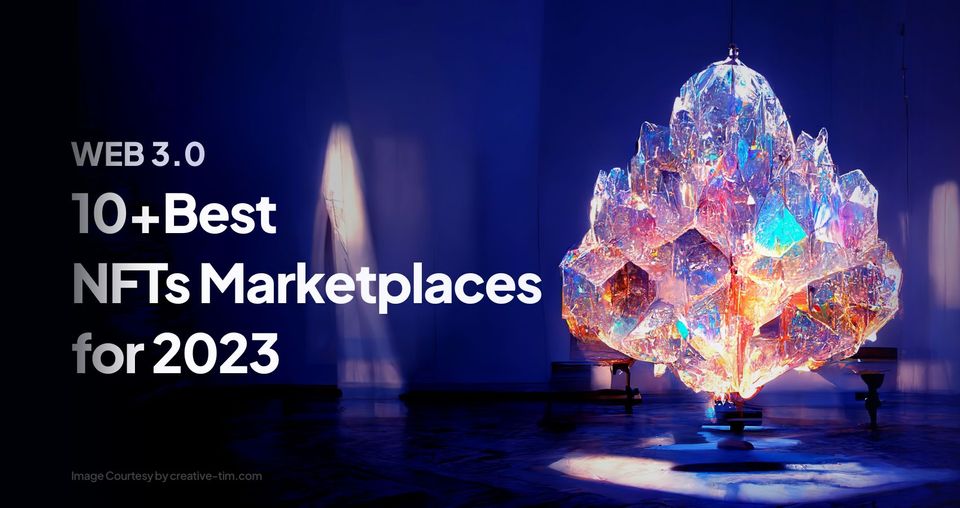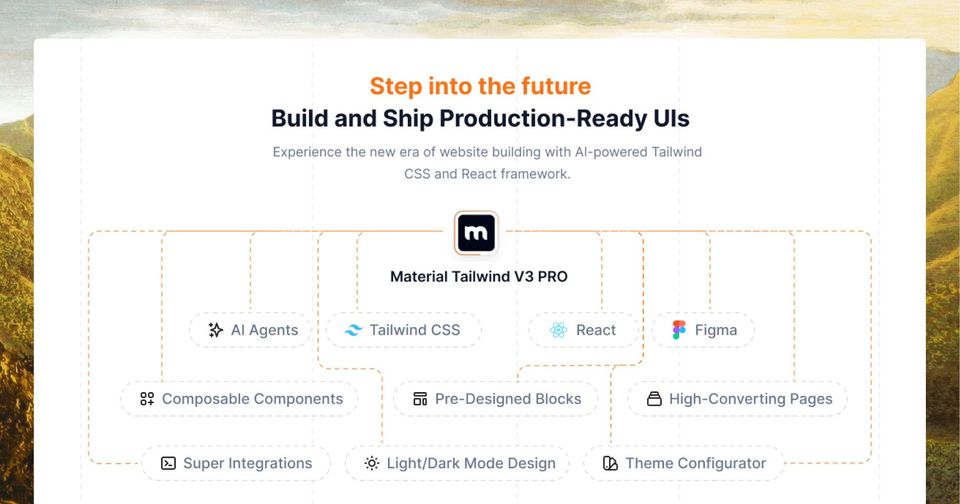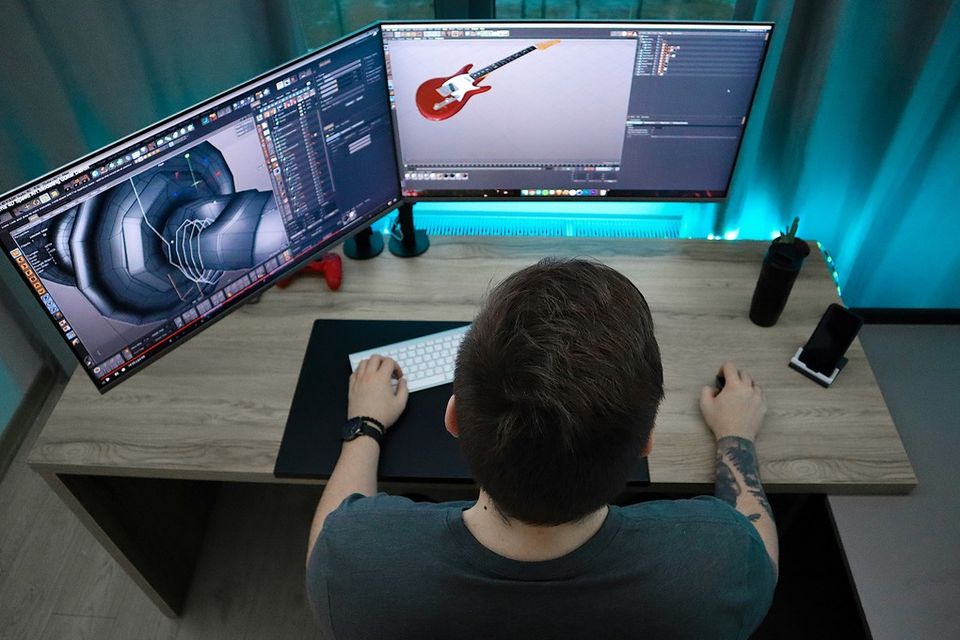NFTs have become increasingly popular since the first one, Quantum, was minted in May 2014. But it wasn’t until three years later that widespread adoption of this new technology was witnessed. Interestingly, this coincided with the formation of the first NFT marketplace, OpenSea, in 2017.
The NFT marketplace opened the doors for everyone to join the NFT train. Overnight, anyone could publish NFTs, and anyone could buy them. NFTs went from a niche within the crypto and blockchain universe to one of the most talked about technologies.
Whether you are an artist, collector, or both and are looking to get into NFT or keep up with 2023 trends, you need to choose the best marketplace. Given the numerous options available, it can be a daunting task. Your choice of a marketplace will define how easily you navigate this space.
In this article, we will examine what NFT marketplaces are, how they work, how to choose one, and provide you with a list of the ten best marketplaces you can explore.
But First, What Are NFTs?
Non-fungible tokens, or NFTs, are digital representations of assets from the physical or virtual world in the blockchain. They can represent anything from art, real estate, and video clips to images, concert tickets, tweets, etc.
NFTs are tokenized and unique, which means they can’t be replaced with another, unlike fungible tokens like cryptocurrency. You can exchange one bitcoin (fungible token) for another, but you can’t exchange one NFT (non-fungible token) for another NFT.
NFTs are created through a process called minting. To mint an NFT, upload a file representing your assets (e.g., a JPEG image) to the blockchain. The file metadata will contain all relevant information, such as name, creator details, minting time, traits, and other properties to describe the NFT. One of the easiest ways to create an NFT is by minting it in an NFT marketplace.
For more details, read this article which includes an extensive research on what NFTs actually are.
What Is an NFT Marketplace?
An NFT marketplace is a blockchain-based online platform to trade (sell and buy), display, and store NFTs. You can think of an NFT marketplace as an eCommerce store that lets you exchange your non-fungible tokens for cryptocurrencies or money.
Each NFT marketplace operates on its own system. Typically, they’ll allow you to trade your NFTs in two ways: selling/buying a token for a fixed price or at an auction. If you plan to mint and trade your own NFTs, look for invoicing templates that come with customization features that help you track your NFT sales.
Since the NFTs marketplaces run on the blockchain (the only technology capable of creating non-fungible tokens), they can allow you to mint NFTs on their platform. Some are free, and others will charge you to create NFTs. Typically, these marketplaces make money by charging users a gas fee when they mint, buy, or sell their NFTs.
To use NFT marketplaces, you’ll need three things:
- A user account: To perform any NFT transaction, you must create an account at the marketplace of your choice.
- A crypto wallet: You will use your crypto wallet to hold and access your NFT assets. The wallet has private keys allowing you to transfer and sell/buy an NFT. You should ensure that your NFT wallet is compatible with the marketplace you are using.
- Cryptocurrencies: To mint, list, or buy NFTs, you will need to pay an amount called a gas fee, which is often denoted in cryptocurrencies. Therefore, your crypto wallet should contain cryptocurrencies supported by the marketplace so you can complete your transactions. (Some marketplaces accept fiat currency.)
10 Best NFTs Marketplaces
Before we dive into the ten best NFT marketplaces, you should know of the two types of NFT marketplaces:
- General NFT Marketplaces: They are also known as streamlined marketplaces and are more flexible. They list different kinds of NFTs, accept different forms of payment, and are the most widely used.
- Niche NFT Marketplaces: This type of NFT marketplace only lists exclusive or specific NFTs, usually accepts only specific cryptocurrencies, and offers advanced services.
With that out of the way, here are ten of the best NFT marketplaces.
1. OpenSea

OpenSea is the world’s first and most prominent NFT marketplace — and, thanks to its first-mover advantage, the largest one. The platform is the most accessible and allows anyone to easily create, sell, and buy NFTs. Additionally, the platform is decentralized, and all activities are recorded in the blockchain.
OpenSea supports three blockchains: Ethereum, Polygon, and Klatyn, and they all bring their advantages. Ethereum is one of the leading NFT blockchains, offering users a broad market. Polygon, on the other hand, enables cross-blockchain interaction and allows for free trading.
One of the best-selling features of OpenSea is its easy-to-use and beginner-friendly approach. It allows anyone with no prior NFT experience to mint, buy, and sell NFTs by following simple prompts.
OpenSea’s broad user base makes it easier for creators to showcase their work to more people and find buyers quickly. Finally, the platform allows for both fixed-price selling and auctioning.
2. Foundation

Foundation is an NFT marketplace designed for digital creators to sell their art as NFTs. The platform is based on the Ethereum blockchain and only accepts ether as payment. The marketplace features a bidding process that allows users to buy and sell their pieces in decentralized auctions.
While the platform allows for the selling and buying of NFTs, the process functions differently. Virtually anyone with ETH can create an account to buy NFTs on Foundation; however, you must get an invite to sell or feature your art on the platform. You can get an invite code from a creator already accepted on the marketplace or publish your art on Foundation’s discord, and hope creators choose you.
Foundation also offers creators the chance to monetize their digital art forever. Whenever art is resold, a creator earns a 10% commission in royalties. But the platform has its drawbacks as well. For instance, you will be charged a 15% fee when you sell an NFT.
3. Rarible
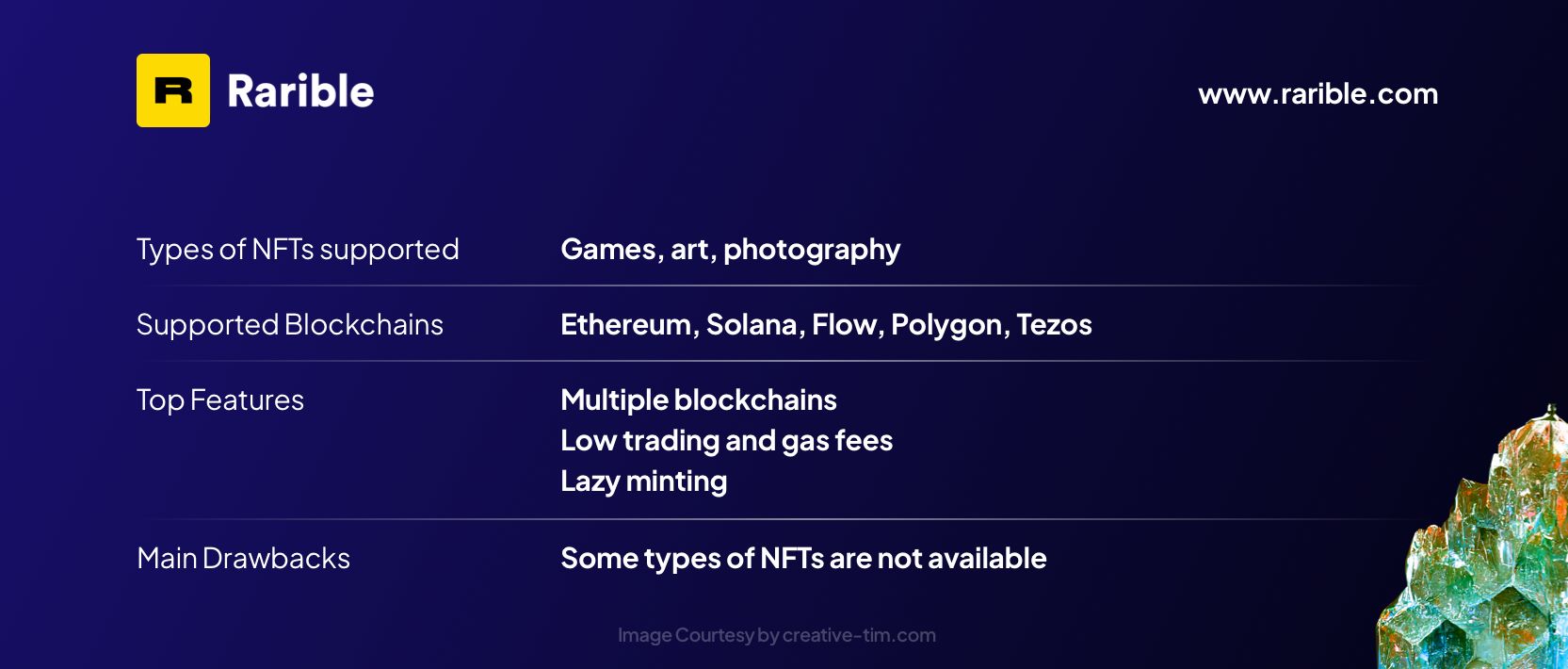
Regarding NFT minting and trading, fees are the number one concern for most people, especially the novice. Rarible is an NFT marketplace created to address the needs of those beginners. The platform combines many features that keep fees low and increase accessibility.
Rarible is a multichain marketplace and supports five blockchains: Ethereum, Solana, Flow, Polygon, and Tezos. This allows you to choose the blockchain that aligns with your needs. For instance, Ethereum will give you access to the biggest crowd, while Flow allows you to mint NFTs for free when using Rarible.
Rarible fees are competitively low as well. The platform charges both the buyer and seller a 1% fee. The marketplace also supports free minting on the blockchain through lazy minting. If you enable this feature, the buyer of your NFT will cover the minting fees. The downside is that this feature can turn away potential customers unwilling to pay your minting fees.
Overall, Rarible is an accessible, beginner-friendly marketplace. They support over 20 currencies and allow users to purchase NFTs using credit cards. However, you should keep the drawbacks in mind. For instance, while fees might seem low, they can add up quickly depending on the blockchain and payment option you use. Additionally, the collections on the platform could be better. Some NFT categories, such as music and videos, are not available.
4. SuperRare
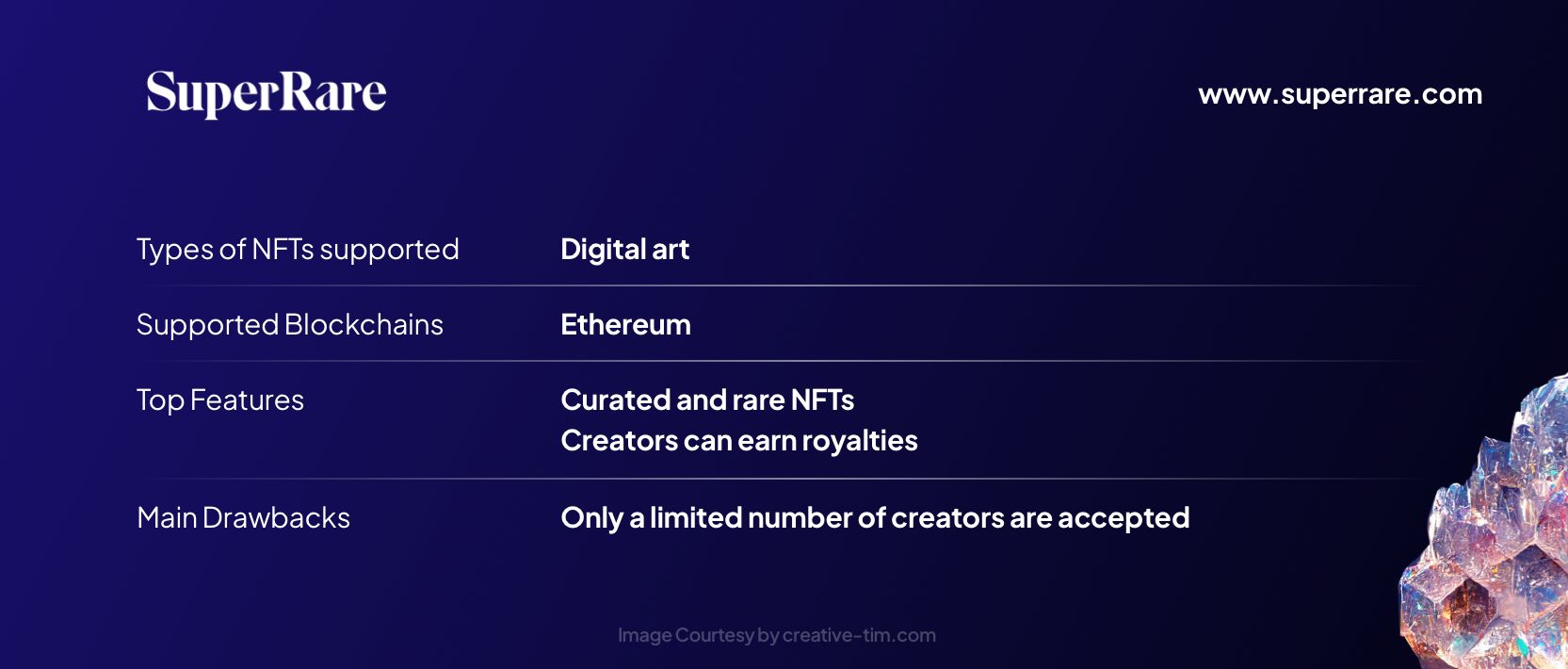
SuperRare is an exclusive NFT marketplace and, like Rarible, has a small number of artists. The platform works like a private art gallery since its developers carefully curate the type of artwork listed on the marketplace. To list an NFT, digital artists must first apply and get approval from the platform.
By carefully curating its platform, SuperRare ensures that only high-quality NFTs get listed and fraud is minimized. This exclusivity allows NFT creators to generate higher sales and collectors to find quality products.
Regarding costs, SuperRare charges more premium fees compared to other marketplaces. For their first release, creators receive 85% of the final sale price, with SuperRare pocketing the rest. Buyers are also charged an additional 3% marketplace fee on every purchase they make on the platform. However, creators can receive a 10% royalty for each subsequent sale of their NFTs.
The other downside of SuperRare is that it runs exclusively on the Ethereum blockchain and only accepts ether as payment. Minting on this blockchain increases your chances of selling but also charges higher gas fees.
Check out our comprehensive research on the top blockchains for 2023!
5. Binance NFT
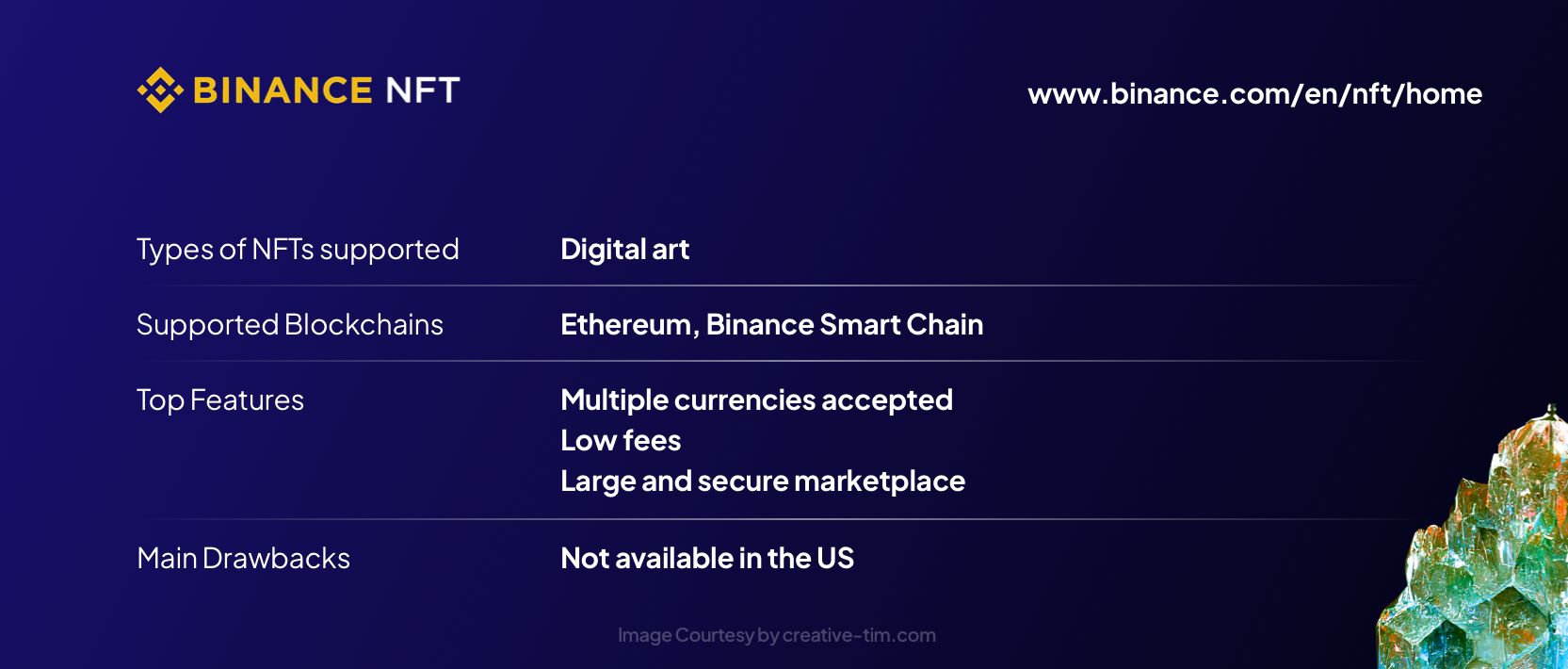
Binance is one of the biggest centralized crypto exchanges and trading platforms in the world and has been around since 2017. The exchange is known for its massive user base, low fees, advanced features, and user-focused approach. In 2021, the exchange launched its marketplace to increase NFT accessibility. The platform allows people to buy and sell all categories of NFTs and accommodates different types of creators and artists.
One of the biggest advantages Binance NFT has over other marketplaces is low fees. It charges only 1% on every transaction, and listing NFTs is free. Users can also reduce fees by minting on Binance Smart Chain, which charges 0.000001 BNB. There are also no costs for transferring NFTs, but you will still pay gas fees which can be high when using Ethereum, the only other blockchain supported by Binance NFT.
The marketplace supports three payment methods, BNB, ETH, and BUSD, the platform’s native stablecoin. Since the marketplace integrates with the Binance exchange, you can also easily use cash to buy these cryptos.
The platform also has its share of drawbacks. For starters, the NFT marketplace isn’t accessible on Binance’s U.S. subsidiary Binance.US. Second, only pre-approved artists can mint NFTs, and lastly, the platform pays creators a low royalty of only 1%.
6. Nifty Gateway
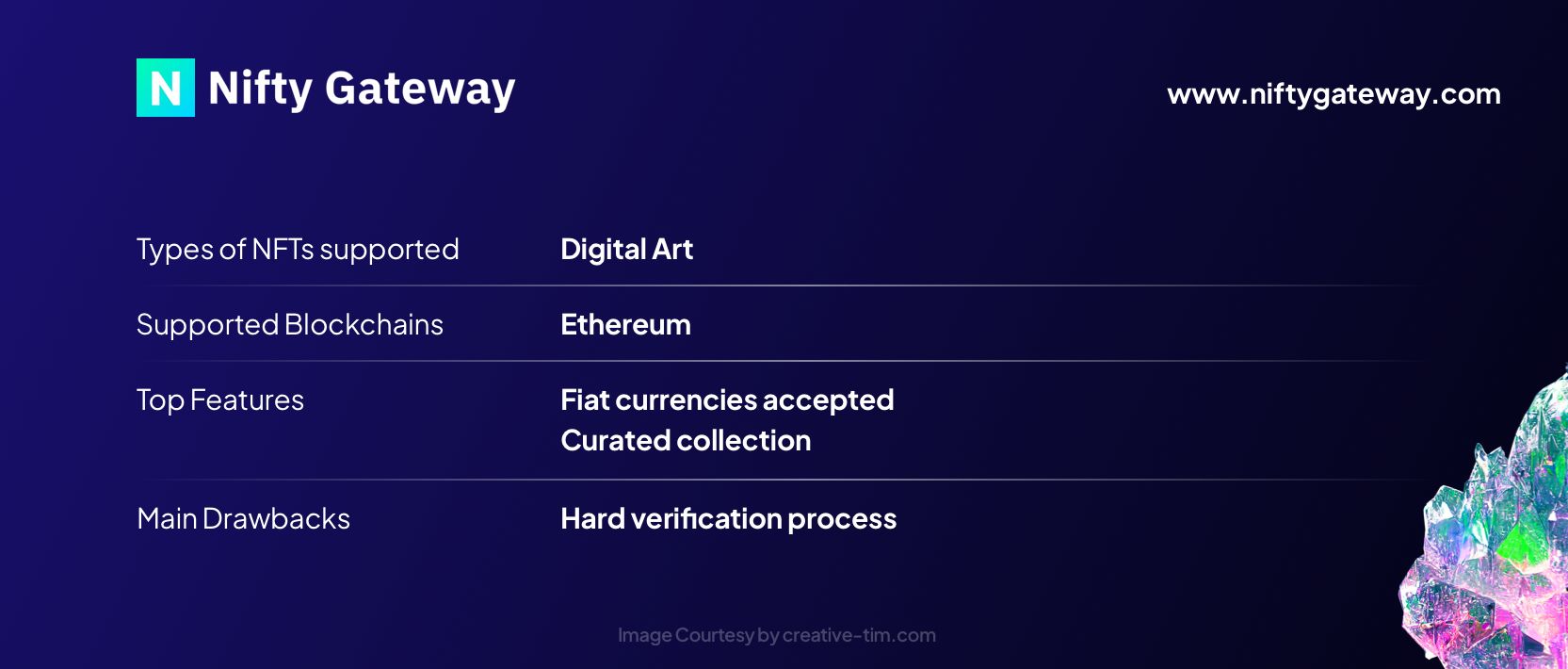
Nifty Gateway is an NFT marketplace owned and operated by Gemini, a cryptocurrency exchange platform. The platform has a lot in common with SuperRare; they exclusively focus on top-quality digital arts and curated collections. Before you mint or list NFTs on the platform, you must undergo a rigorous verification process.
This exclusivity has helped Nifty Gateway to build a reputation as the most premium marketplace. Top creators looking to sell their digital art for premium prices flock to the platform, and collectors and NFT investors put more value on Nifty Gateway drops. Interestingly, Beeple’s CROSSROAD and Pak’s The Merge, two of the most expensive NFTs, were sold on this marketplace.
Nifty Gateway is an Ethereum-based platform. But despite this, minting on the platform is free, as Nifty Gateway covers 100% of the costs. You will only need ETH to pay a gas fee when transferring NFTs between wallets. Additionally, the platform allows users to buy NFTs using a debit/credit card.
You should also note that Nifty Gateway charges a 2.5% listing fee when you sell an NFT.
7. Magic Eden
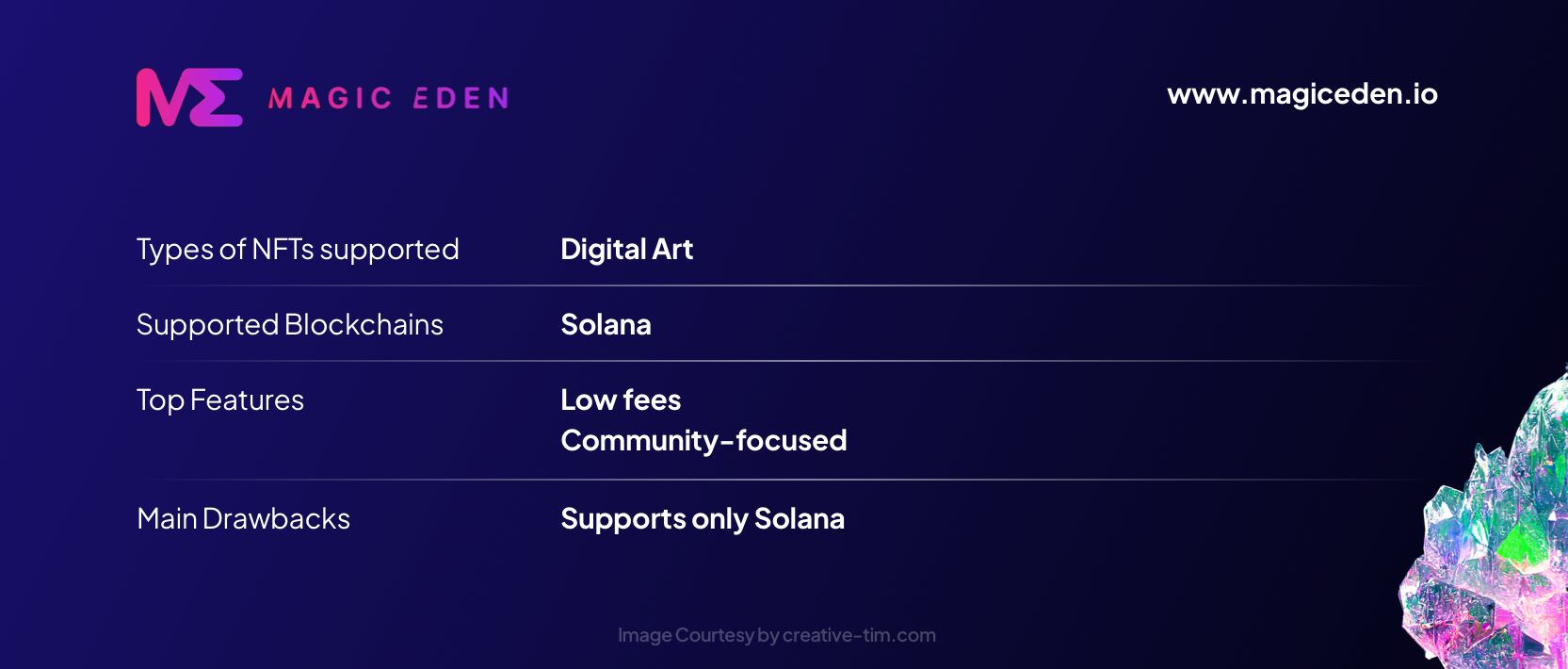
Magic Eden is the largest decentralized NFT marketplace on the Solana blockchain. The platform went live in January 2021 and allowed anyone to trade NFTs without going through a third party.
The marketplace also allows users to mint new NFTs easily. Creators must first submit an application to the platform launchpad program by filling out a form. Since Magic Eden runs on Solana, you will need the blockchain native cryptocurrencies (SOL) to create an NFT. Additionally, if you already have an NFT, you will need to verify it before it’s listed on Magic Eden.
One of the key advantages of Magic Eden is its low fees. First, listing an NFT is free, and the marketplace only charges a 2% fee on all transactions. Second, bidding for an NFT on the platform is also free.
The marketplace is also community-focused, has a diverse range of NFT projects, and gives more control to creators. For instance, it’s up to the artists to decide the amount of royalty they want to earn for the subsequent sale of their NFTs.
8. Mintable
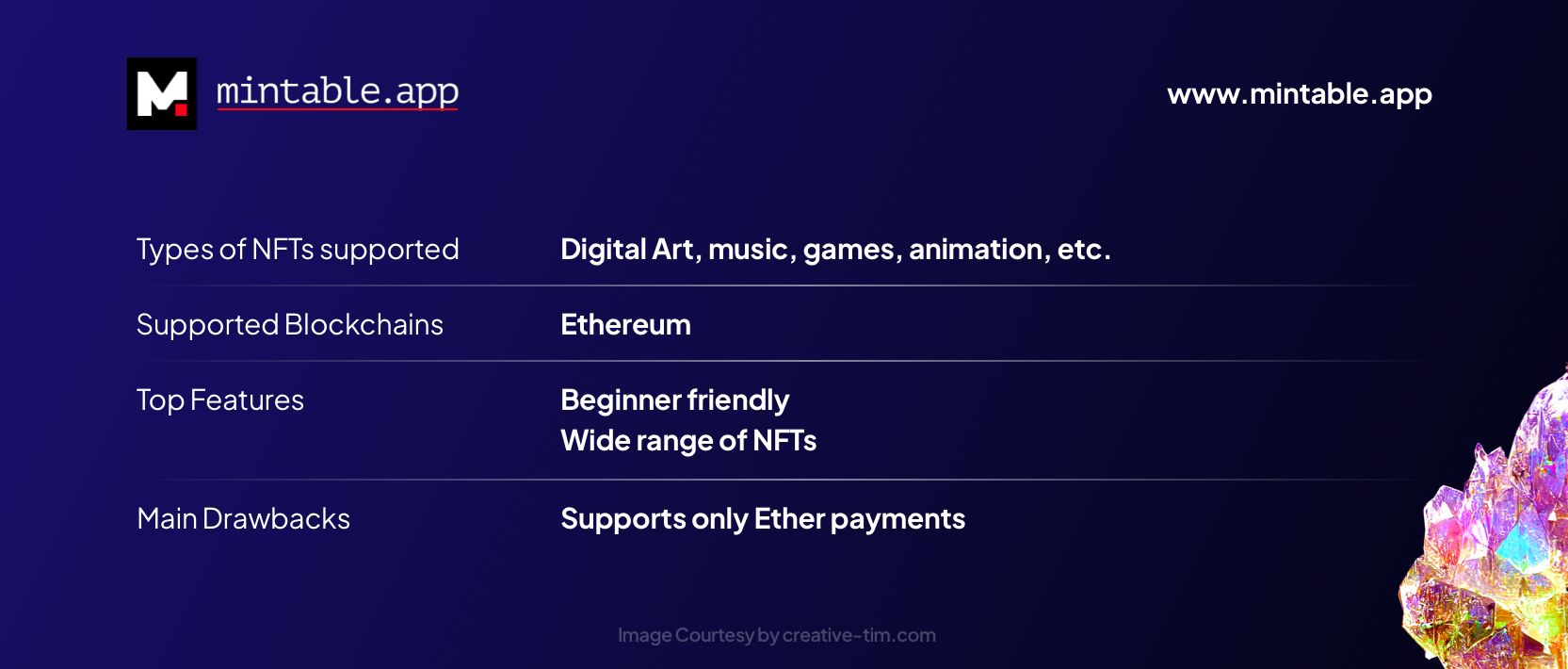
Mintable is an Ethereum-based marketplace that allows new NFT investors to mint and trade non-fungible tokens with ease. The platform has a wide range of features that set it apart from other marketplaces, starting with its rich selection of NFTs. You can access all kinds of digital art, from music, videos, audio, text documents, GIFs, etc.
But the feature that makes Mintable stand out is the free minting process. Users can create and list NFTs from JPEGs, video clips, audio files, etc., for free. This gas-free method is made possible by Ethereum’s ImmutableX protocol and Mintable gasless minting API Mintology.
Mintable also has its drawbacks starting with high transaction costs. Transaction fees start at 2.5% for normal NFTs but can rise to 10% on printable items. Another of Mintable limitations is its wallet and currency requirement. They only support Metamask crypto wallet and ether for payments.
9. LooksRare
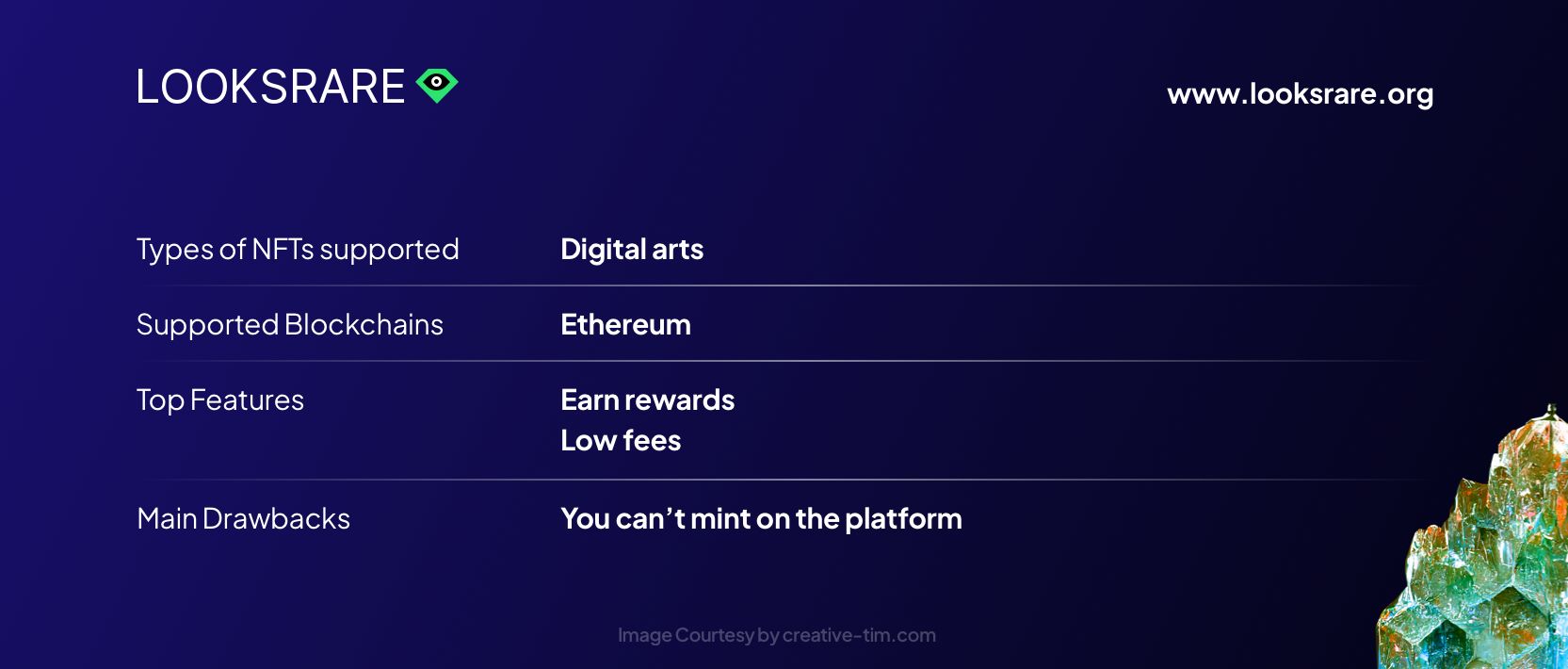
If you are looking for a community-driven marketplace that rewards users for trading NFTs, LooksRare is your platform. The marketplace was launched in early 2022 with the aim of taking over the space, and thanks to its attractive incentives, they have grown rapidly.
LooksRare keeps transaction costs low and has a reward-based business model to attract users. Traders earn LOOKS coin (the platform’s native digital token) for participating in the NFT marketplace by buying or selling NFTs. Additionally, It also allows creators to set their royalty fees.
LooksRare charges a flat fee of 2% on sales, which is lower than what most marketplace charge. Another thing to keep in mind is that the platform is Ethereum-based. You will need to pay a gas fee when you deposit, withdraw, or transfer NFTs. Additionally, ether is the only acceptable currency.
The most significant drawback of LooksRare is that users can’t mint new NFTs on the platform; it only allows you to buy or sell. Additionally, browsing for specific NFTs categories is restricted. This limited functionality can turn off collectors interested in niche category NFTs.
10. XOXNO
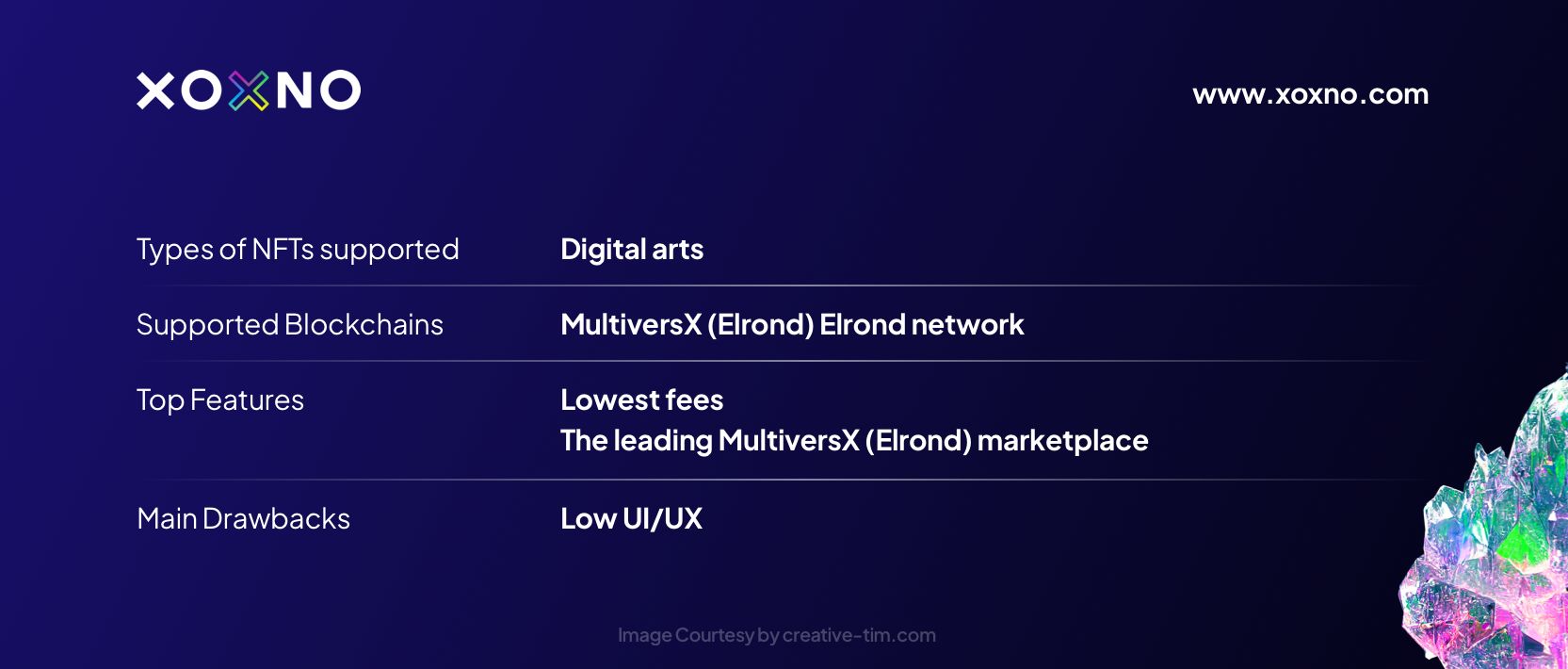
XOXNO is the leading marketplace on the MultiversX (Elrond) Network that offers a range of tools for users and creators alike. One of its standout features is the automatic royalty distribution mechanism for NFT sales, which ensures that creators receive a fair share of the proceeds. XOXNO also offers advanced staking pools with various options and rewards.
XOXNO’s most significant advantage, apart from its notable collection of the best and most popular NFTs on the MultiversX (Elrond) blockchain, is its affordability. It has among the lowest fees for NFT sales, with a 1% trading fee and 0% listing fee.
This year, the platform has also expanded to support fiat payments in EUR and RON, making it even easier for users to buy and sell NFTs using Visa or Mastercard.
NF-Tim by Creative Tim - the NFTs collection for Developers, Designers, Creators, and NFT fans based on MultiversX - can be found on XOXNO!
11. DeadRare
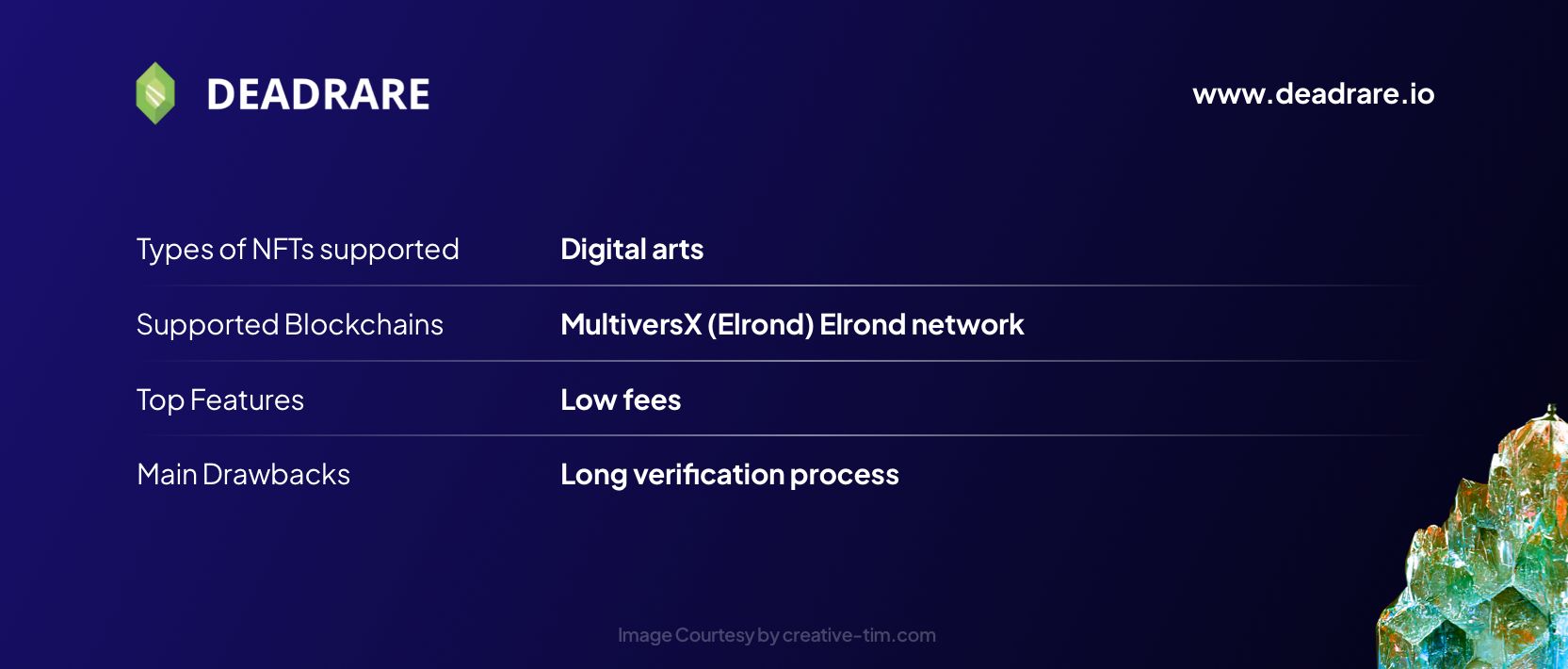
DeadRare is another decentralized NFT marketplace based on the MultiversX (former Elrond) network and allows users to buy and sell Elrond-based NFTs. You will need the network’s native currency, EGLD, to buy, sell, or mint on DeadRare.
DeadRare aims to promote creators by providing them with a trustless marketplace to share their art. The platform not only honors royalties but also gives creators the freedom to set how much they want to receive.
The platform charges no listing fees and takes only a 2% commission on all completed sales.
To buy an NFT on the DeadRare marketplace, you will need to bid by sending an offer to the NFT owner. The specified EGLD you indicated on your offer will be held in the platform’s smart contract. You will receive your crypto back in your account if the offer is rejected.
For creators, to get your art verified on DeadRare, you will need to message the platform’s discord channel.
Conclusion - Choosing the NFT Marketplace
NFTs marketplaces vary greatly, and each has its own features that set them apart. The type of platform you choose will decide how successful you will be in trading or minting NFTs. It’s, therefore, not a surprise that a lot of thought will go into picking an NFT marketplace.
Here are some things you should consider when choosing an NFT marketplace.
- Blockchain: The type of blockchain network the NFT marketplace runs on will decide the kind of cryptocurrencies you need to transact, how much you will pay in gas fees, and how easily you can buy or sell your NFTs. It’s imperative that you choose one that aligns with all your needs.
Want to learn more about what a blockchain is? Read this article!
- Type of marketplace: While most platforms have an easy and direct way to purchase NFTs, some make it harder for users to list or mint NFTs on their platforms. OpenSea, for instance, is more accessible than Foundation.
- Type of project offered: Some platforms, like Rarible, are multi-project and list various NFTs. Other marketplaces are more niche and only offer single projects typically minted on their platform.
- Marketplace reviews: Before trading or minting any NFTs, take time to conduct some research, read reviews and ensure that the marketplace you choose is legitimate.
- Security: Considering that you will connect your crypto wallet and offer other KYC information to marketplaces, always ensure you pick a secured platform. Choose an NFT marketplace that Encrypts your data on transit, is transparent about its security measures, and offers self-custody features.
Disclaimer: This article is intended for general guidance and information purposes only. The contents of this article are not to be construed as legal, business, investment, or tax advice. You should consult with your advisors for all legal, business, investment, and tax implications and advice.
Resources:
- https://www.forbes.com/sites/stevenehrlich/2021/07/06/nft-marketplace-ceo-explains-why-the-industry-is-moving-beyond-ideological-purists
- https://news.bitcoin.com/the-worlds-largest-nft-marketplace-opensea-adds-bnb-blockchain-support
- https://www.coindesk.com/learn/rarible-nft-marketplace-how-to-get-started
- https://fortune.com/2022/04/05/looksrare-nft-marketplace-challenging-opensea-wash-trades-win-rewards-coins
- https://coinmarketcap.com/alexandria/article/binance-is-launching-an-nft-marketplace-with-some-of-lowest-fees-in-the-industry
- https://elrond.com/blog/elrond-nft-space
- https://www.blockchain-council.org/nft/nifty-gateway
- https://www.businessinsider.com/personal-finance/mintable-nft-review

